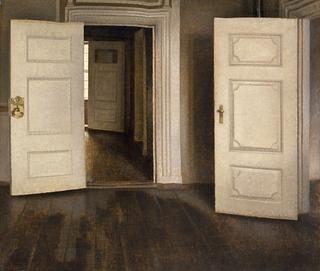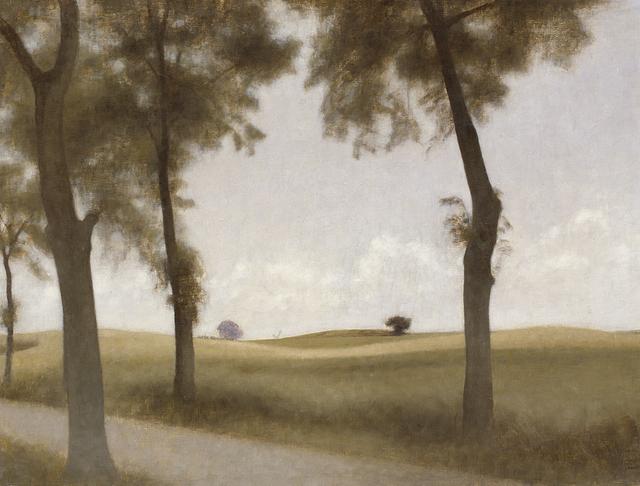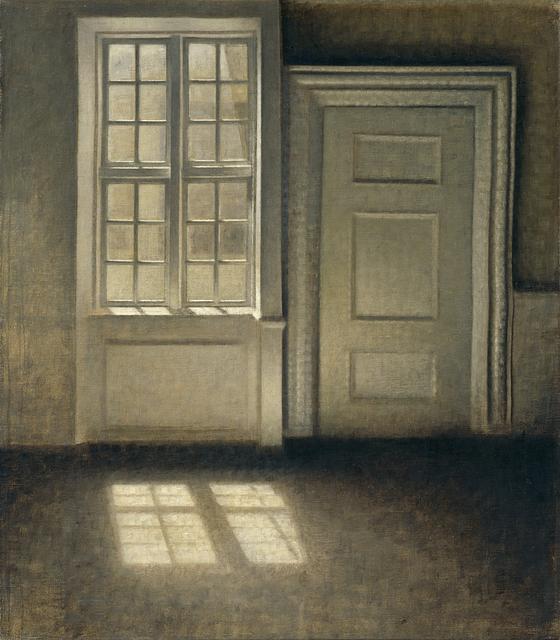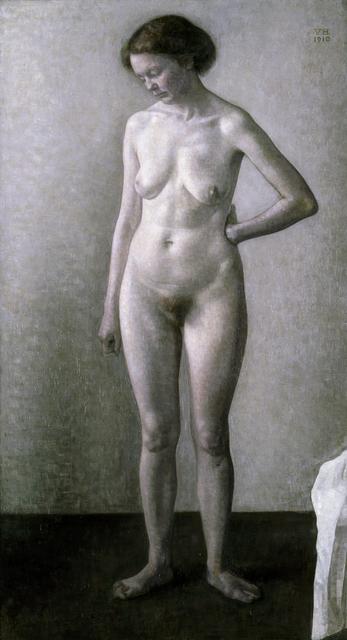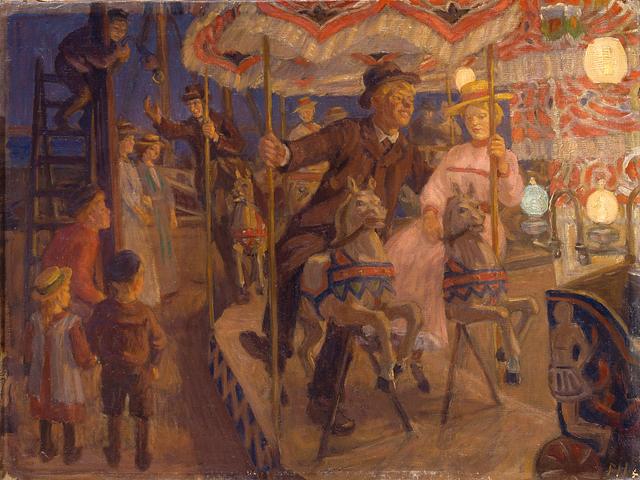Vilhelm Hammershøi (1864–1916)
Open Doors, 1905
Oil on canvas
52 x 60 cm
Inventory number B 309
During the years around the turn of the century, interior scenes were a popular genre within the art of painting. The subject sold well to affluent art audiences, and at the same time there was a general trend towards celebrating – and protecting – the home, the private, intimate sphere in an age when modern, vibrant city life reached new and hectic heights. Vilhelm Hammershøi was by no means the only painter who showed an interest in interior scenes, but he stood out from the crowd by his concerted focus on the theme and by his approach to exploring the spatial aesthetics and compositional possibilities found in the interiors of his own successive homes.
In the years 1898 to 1908, Hammershøi lived in a flat at Strandgade 30 in Copenhagen. At this address he created approximately sixty-six interior scenes, accounting for almost half of his total production during the period, which came to some 142 paintings all in all.1 Open Doors was painted in the flat’s dining room, which Hammershøi depicted in approximately twenty paintings. This makes the dining room the most frequently used subject in his oeuvre. However, these paintings should not be seen as a series, but rather as variations on a basic theme that is examined and tested in new constellations, with or without furniture and figures.2
The main subject of the picture is the three open doors. They are all white and wide open, and together they seem to be the only movable elements in the empty spaces, where everything is uncompromisingly arranged and simplified in a tight composition built up of lines and surfaces. Hammershøi has stood with his back to the dining room’s two windows facing the street, which is why the strong light falling in from behind the artist can be sensed in the reflections in the doors, the panels and the dark-stained floor’s varnished surface in the foreground. The left door opens on a perspective view through the adjoining rooms, in which a strong backlight from the courtyard can be seen. Hammershøi offers no further impression of the rooms we are looking through, nor does he reveal whereto the doors lead.
In the years 1898 to 1908, Hammershøi lived in a flat at Strandgade 30 in Copenhagen. At this address he created approximately sixty-six interior scenes, accounting for almost half of his total production during the period, which came to some 142 paintings all in all.1 Open Doors was painted in the flat’s dining room, which Hammershøi depicted in approximately twenty paintings. This makes the dining room the most frequently used subject in his oeuvre. However, these paintings should not be seen as a series, but rather as variations on a basic theme that is examined and tested in new constellations, with or without furniture and figures.2
The main subject of the picture is the three open doors. They are all white and wide open, and together they seem to be the only movable elements in the empty spaces, where everything is uncompromisingly arranged and simplified in a tight composition built up of lines and surfaces. Hammershøi has stood with his back to the dining room’s two windows facing the street, which is why the strong light falling in from behind the artist can be sensed in the reflections in the doors, the panels and the dark-stained floor’s varnished surface in the foreground. The left door opens on a perspective view through the adjoining rooms, in which a strong backlight from the courtyard can be seen. Hammershøi offers no further impression of the rooms we are looking through, nor does he reveal whereto the doors lead.
Published in
Published in
Fortegnelse over arbejder af Vilhelm Hammershøi, [2], Kunstforeningen April-Maj 1916, København 1916, cat.no. 55, p. 6;
Sophus Michaëlis and Alfred Bramsen: Vilhelm Hammershøi. Kunstneren og hans værk, København 1918, cat.no. 275, pp. 61, 104;
Erik Zahle: ”Malerisamlingens vækst” in C.L. Davids Samling, Tredie del, København 1958, pp. 127, 162-163;
C.L. David: C.L. Davids Samling, København 1960, p. 28 (mentioned);
Det besjälade rummet, Malmö Museum, Malmø 1975, p. 23;
Knud Voss and Verner Aspenström: Vilhelm Hammershøi, Prins Eugens Waldemarsudde, Stockholm 1976, cat.no. 26, p. 29;
Grete Zahle: Dansk Kunst 1885-1915, Kunstforeningen, København 1976, cat.no. 72, p. 64;
Hanne Finsen, Inge Vibeke Raaschou-Nielsen: Vilhelm Hammershøi: en retrospektiv udstilling, Ordrupgaard, Charlottenlund 1981, cat.no. 106, p. 127;
Kirk Varnedoe: Northern light. Realism and symbolism in Scandinavian painting, 1980-1910, Brooklyn Museum, New York 1982, cat.no. 31, pp. 128-129;
Henrik Wivel: Symbolisme og impressionisme, København 1994, p. 100. (Nyere Dansk Kunsthistorie; 5);
Poul Vad in Kjeld von Folsach and Nana Lund (eds.): Dansk kunst i Davids Samling – fra Philipsen til Saxbo, København 1995, cat.no. 35, pp. 100-101;
Henrik Wivel: Vilhelm Hammershøi: dansk klassikerkunst, København 1996, fig. 19, p. 38, 45;
Anne-Birgitte Fonsmark et al.: Vilhelm Hammershøi, 1864-1916. Danish painter of solitude and light, Ordrupgaard, Charlottenlund, Musée d’Orsay, Paris, Solomon R. Guggenheim Museum, New York 1998, cat.no. 38, p. 101;
Sabine Schulze: Innenleben. Die Kunst des Interieurs. Vermeer bis Kabakov, Städelsches Kunstinstitut und Städtische Gallerie, Frankfurt, Ostfildern 1998,cat.no. 79, pp. 256-257;
Lena Boëthius, Görel Cavalli-Björkman (eds.): Vilhelm Hammershøi, Göteborg Konstmuseum and Stockholm Nationalmuseum, Göteborg 1999, pp. 8-9, 11;
Felix Krämer, Ulrich Luckhardt, Barbara Ludwig: Vilhelm Hammershøi, Hamburger Kunsthalle, Hamburg 2003, cat.no.. 37, pp. 19-20, 71, 154;
Bente Scavenius and Jens Lindhe: Hammershøis København, Kunstforeningen GL STRAND, København 2003, pp. 70-71;
Poul Vad: Hammershøi. Værk og liv, København 2003, 5. ed., pp. 230, 319, 411;
Tone Sinding Steinsvik, Ida Lorentzen, Bente Scavenius: Den forunderlige stillheten: Ida Lorentzen (f.1951), Vilhelm Hammershøi (1864-1916), Stiftelsen Modums Blaafarveværk, Modum 2005, cat.no. 54, pp. 92, 97;
Frances Borzello: At Home. The Domestc Interior in Art, London 2006;
Annette Rosenvold Hvidt (ed.): Hammershøi – Dreyer: Billedmagi, Ordrupgaard, Charlottenlund 2006, cat.no. 34, pp. 22, 120;
Felix Krämer, Naoki Sato and Anne-Birgitte Fonsmark: Hammershøi, Royal Academy of Arts, London 2008, cat.no. 44, pp. 34, 86-87, 152;
Henrik Wivel: ”Åndemusik. Vilhelm og Svend Hammershøi i deres samtid” in Anne-Mette Villumsen, Iben Overgaard, Sidsel Maria Søndergaard (eds.): Svend Hammershøi: en kunstner og hans tid, Skovgaard Museet, Viborg 2008, pp. 20-21;
Jens Christian Grøndahl: Om en time springer træerne ud: erindringer, København 2010, p. 30;
Kasper Monrad et al.: Hammershøi og Europa, Statens Museum for Kunst, København 2012, cat.no. 81, pp. 98, 105;
Felix Krämer: “Modern Art” in Masterworks in dialogue. Eminent guests for the anniversary, Städel Museum, Frankfurt am Main 2015, cat.no. 19, pp. 115, 121;
Anne-Birgitte Fonsmark, Jacob Bach Riis (eds.): Hjemme hos Hammershøi, Ordrupgaard, Charlottenlund 2016, cat.no. 65, fig. 16, p. 23 and fig. 90, pp. 98-99;
Henrik Wivel: Hammershøi i Davids Samling, København 2017, pp. 74-75;
Annette Rosenvold Hvidt and Gertrud Oelsner: Vilhelm Hammershøi. På sporet af det åbne billede, København 2018, p. 270;
Eva Pohl: ”Se Hammershøi over skulderen” in Nordisk Tidsskrift, 2018, 1, pp. 13-15;
Lisbeth Smedegaard Andersen: Gådefuld bør man være: Vilhelm Hammershøi og inspirationen fra Søren Kierkegaard, København 2019, p. 159;
Hanneke Grootenboer: The Pensive Image. Art as a Form of Thinking, Chicago 2020, fig. 16, pp. 105-106;
Kathrin Baumstark (ed.): Nolde und der Norden, Bucerius KUNST Forum, Hamburg 2021, fig. 45, p. 211;
Johanne Bornemann Mogensen: Malet: maling, farver og teknik i 1900-tallets arkitektur, København 2022, p. 25;
Sophus Michaëlis and Alfred Bramsen: Vilhelm Hammershøi. Kunstneren og hans værk, København 1918, cat.no. 275, pp. 61, 104;
Erik Zahle: ”Malerisamlingens vækst” in C.L. Davids Samling, Tredie del, København 1958, pp. 127, 162-163;
C.L. David: C.L. Davids Samling, København 1960, p. 28 (mentioned);
Det besjälade rummet, Malmö Museum, Malmø 1975, p. 23;
Knud Voss and Verner Aspenström: Vilhelm Hammershøi, Prins Eugens Waldemarsudde, Stockholm 1976, cat.no. 26, p. 29;
Grete Zahle: Dansk Kunst 1885-1915, Kunstforeningen, København 1976, cat.no. 72, p. 64;
Hanne Finsen, Inge Vibeke Raaschou-Nielsen: Vilhelm Hammershøi: en retrospektiv udstilling, Ordrupgaard, Charlottenlund 1981, cat.no. 106, p. 127;
Kirk Varnedoe: Northern light. Realism and symbolism in Scandinavian painting, 1980-1910, Brooklyn Museum, New York 1982, cat.no. 31, pp. 128-129;
Henrik Wivel: Symbolisme og impressionisme, København 1994, p. 100. (Nyere Dansk Kunsthistorie; 5);
Poul Vad in Kjeld von Folsach and Nana Lund (eds.): Dansk kunst i Davids Samling – fra Philipsen til Saxbo, København 1995, cat.no. 35, pp. 100-101;
Henrik Wivel: Vilhelm Hammershøi: dansk klassikerkunst, København 1996, fig. 19, p. 38, 45;
Anne-Birgitte Fonsmark et al.: Vilhelm Hammershøi, 1864-1916. Danish painter of solitude and light, Ordrupgaard, Charlottenlund, Musée d’Orsay, Paris, Solomon R. Guggenheim Museum, New York 1998, cat.no. 38, p. 101;
Sabine Schulze: Innenleben. Die Kunst des Interieurs. Vermeer bis Kabakov, Städelsches Kunstinstitut und Städtische Gallerie, Frankfurt, Ostfildern 1998,cat.no. 79, pp. 256-257;
Lena Boëthius, Görel Cavalli-Björkman (eds.): Vilhelm Hammershøi, Göteborg Konstmuseum and Stockholm Nationalmuseum, Göteborg 1999, pp. 8-9, 11;
Felix Krämer, Ulrich Luckhardt, Barbara Ludwig: Vilhelm Hammershøi, Hamburger Kunsthalle, Hamburg 2003, cat.no.. 37, pp. 19-20, 71, 154;
Bente Scavenius and Jens Lindhe: Hammershøis København, Kunstforeningen GL STRAND, København 2003, pp. 70-71;
Poul Vad: Hammershøi. Værk og liv, København 2003, 5. ed., pp. 230, 319, 411;
Tone Sinding Steinsvik, Ida Lorentzen, Bente Scavenius: Den forunderlige stillheten: Ida Lorentzen (f.1951), Vilhelm Hammershøi (1864-1916), Stiftelsen Modums Blaafarveværk, Modum 2005, cat.no. 54, pp. 92, 97;
Frances Borzello: At Home. The Domestc Interior in Art, London 2006;
Annette Rosenvold Hvidt (ed.): Hammershøi – Dreyer: Billedmagi, Ordrupgaard, Charlottenlund 2006, cat.no. 34, pp. 22, 120;
Felix Krämer, Naoki Sato and Anne-Birgitte Fonsmark: Hammershøi, Royal Academy of Arts, London 2008, cat.no. 44, pp. 34, 86-87, 152;
Henrik Wivel: ”Åndemusik. Vilhelm og Svend Hammershøi i deres samtid” in Anne-Mette Villumsen, Iben Overgaard, Sidsel Maria Søndergaard (eds.): Svend Hammershøi: en kunstner og hans tid, Skovgaard Museet, Viborg 2008, pp. 20-21;
Jens Christian Grøndahl: Om en time springer træerne ud: erindringer, København 2010, p. 30;
Kasper Monrad et al.: Hammershøi og Europa, Statens Museum for Kunst, København 2012, cat.no. 81, pp. 98, 105;
Felix Krämer: “Modern Art” in Masterworks in dialogue. Eminent guests for the anniversary, Städel Museum, Frankfurt am Main 2015, cat.no. 19, pp. 115, 121;
Anne-Birgitte Fonsmark, Jacob Bach Riis (eds.): Hjemme hos Hammershøi, Ordrupgaard, Charlottenlund 2016, cat.no. 65, fig. 16, p. 23 and fig. 90, pp. 98-99;
Henrik Wivel: Hammershøi i Davids Samling, København 2017, pp. 74-75;
Annette Rosenvold Hvidt and Gertrud Oelsner: Vilhelm Hammershøi. På sporet af det åbne billede, København 2018, p. 270;
Eva Pohl: ”Se Hammershøi over skulderen” in Nordisk Tidsskrift, 2018, 1, pp. 13-15;
Lisbeth Smedegaard Andersen: Gådefuld bør man være: Vilhelm Hammershøi og inspirationen fra Søren Kierkegaard, København 2019, p. 159;
Hanneke Grootenboer: The Pensive Image. Art as a Form of Thinking, Chicago 2020, fig. 16, pp. 105-106;
Kathrin Baumstark (ed.): Nolde und der Norden, Bucerius KUNST Forum, Hamburg 2021, fig. 45, p. 211;
Johanne Bornemann Mogensen: Malet: maling, farver og teknik i 1900-tallets arkitektur, København 2022, p. 25;
Footnotes
Footnotes
1.
Henrik Wivel: Hammershøi in the David Collection, The David Collection, Copenhagen 2017, p. 74.
2.
The figures are based on Alfred Bramsen’s inventory of Hammershøi’s works, but it should be noted that Bramsen’s list is not complete.
Paintings and drawings
